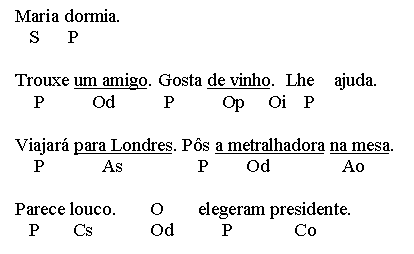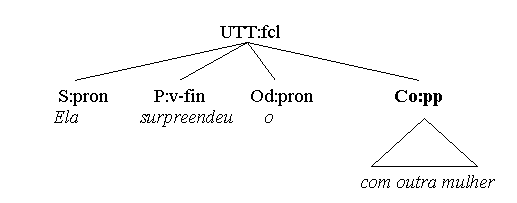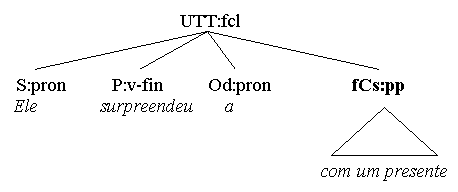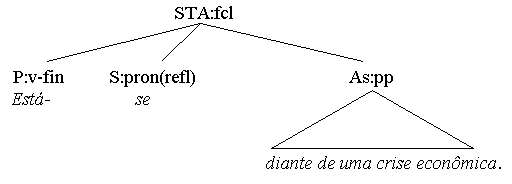| Portuguese VISLSentence AnalysisEdutainmentCorporaDictionariesMachine Translation |
Eckhard Bick
PORTUGUESE SYNTAX
3. Clause level functions
Clause level arguments (valency governed)
The functional pivot of most clauses is a verbal constituent (V), also called predicator (P). Complex verb chains can consist of both main verbs (MV) and auxiliaries (AUX), linked by a dependency relation, and possibly by an auxiliary subordinator (SUBaux). For the sake of simplicity, we will here stick to single verbs, and treat complex predicators in another chapter.
In Portuguese, there are four main types of clause level arguments, the subject (S), objects (O), argument adverbials (A) and complements (C). Objects are subclassified according to pronominal case, argument adverbials and complements as to whether they relate to the subject or - if present - to the direct object. In the examples, complex constituents are "united" by underlines.

The different types of arguments in the examples can be distinguished by pronominal substitution:
S (subject) demands nominative case when pronominalized (eu, tu). The subject has person and number agreement with its clause's finite verb (or, possibly, leading infinitive).
Oacc (direct or accusative object) demands accusative case when pronominalized (o, a, os, as): "Trouxe-o". Both S and Oacc can be pronominalized with "o_que".
Opiv (prepositional object) is always a pp [prepositional phrase] and demands prepositional case (also called oblique or prepositive: mim, ti) when the argument of its preposition is substituted by a pronoun: "Gosta de ti." Adverbials can be pp's, too, but prepositional objects can be distinguished from argument adverbials (or adverbial objects, A) by the fact that they can't be replaced by adverbs, and from adjunct adverbials by the fact that they are valency bound (cp chapter 3.2).
Odat (pronominal dative object) is the function assigned to the pronominal form 'lhe'. Dative objects typically occur as optional number 2 object in the presence of a number 1 direct object (Oacc): "Lhe (Odat) dá um presente (Oacc)." Lhe alternates with pp-objects introduced by the prepositions 'a' or 'para', which is why such pp's could be regarded as dative objects, too: "Dá um presente a ela (Odat)." The corresponding non-pronominalized construction is, however, (form wise!) indistinguishable from a prepositional object, and will here, for the sake of formal consistency, be tagged as such: "Lhe ajuda" (Odat) - "Ajuda a ele" (Opiv).
C (complements or predicatives) can be substituted by either "tal" or "isto", but normally not by personal pronouns: "Parece tal" (Cs) , "O elegeram isto" (Co) . Complements differ from objects in complementing both the clause's main verb and its subject (Cs) or direct object (Co). That's why they are called predicatives - like adnominal modifiers, they predicate something of a noun, while the clause's main verb is reduced to a kind of connecting device (called copula for the Cs-predicative) without much semantic content of its own. For focusing, Cs can be fronted, while Co can't (rico [Cs] não é - *engraçado [Co] não o acho). Adjectives and participles with predicative function have number and gender agreement with their nominal referent, Cs with the subject, Co with the object.
A (argument adverbials or adverbial objects) can be substituted by an adverbial pronoun: "Viajará lá." (As), "Pôs a metralhadora lá." (Ao). Like complements (C), some argument adverbials (A) can be distinguished with regard to subject or object connection (As and Ao). Place and direction adverbials, in particular, "feel" very "predicative": "Mora lá" (As or Cs?), "Colocou-o lá" (Ao or Co?), and the same is true of "Está bem" (As or Cs?). Still, in all three cases we will folow the adverb substitution test and settle for the adverbial function tag (A). A very special case are the measuring verbs durar [7 horas], custar [7 coroas] and pesar [7 gramas]. Superficially, the arguments of these verbs seem to ask for direct object function (Oacc), but both the accusative pronoun substitution test and the "o_que"-substitution test fail. Only substitution with "quanto"/"tanto" works, and in the framework of this grammar, we will opt for an A analysis (argument adverbial), adding "quanto" - at least where it doesn't alternate with "o_que" - to the short test list of adverbial interrogative pronouns ("onde", "quando", "como").
Each Portuguese verb has a fixed set of valency patterns. The examples given concern "maximal valency", including both obligatory and optional complements:
(b) Durava muito
tempo. (As:np)
(c) Nadarmos regularmente
seria bom para a nossa saúde. (S:icl)
(d) Temia que não
o conseguisse. (Oacc:fcl)
(e) Quis saber quando
voltaria o professor. (Oacc:fcl)
(f) Está com
febre. (Cs:pp)
(g) O perigo a tornou
numa fera. (Co:pp)
<vq> cognitiv S
(human) V que-conj Oacc:fcl (finite subclause)
<v+interr> cognitiv
S (human) V qu-word Oacc:fcl (interrogative subclause)
Clause level adjuncts
(not valency governed)
Adjuncts, while still
being clause level constituents, differ from clause level arguments
in that they aren't bound by verbal valency. We will mark adjuncts by a
little f (for free) in the function symbol. Two main types will be
distinguished here, adjunct (or free) adverbials (fA) and
adjunct (or free) predicatives (fC) . Both
functions (adverbial and predicative) also occur as arguments, i.e. argument
adverbial (A) and argument predicative (or complement - C), respectively.
Like their argument counterparts, all free predicatives and some free adverbials
(especially place and direction adverbials) can be related not only to
the verb, but at the same time to either subject (fCs, fAs) or object (fCo,
fAo) .
The difference between
argument adverbials and adjunct adverbials, or between argument predicatives
and adjunct predicatives, can be tested by the predicate isolation test,
where "fazer" or "acontecer" is used to substitute for the predicate (the
verb plus its arguments). Adjuncts (in italics) can be isolated
from the verb, while valency bound arguments (in bold face) cannot.
(b) Caíu no
chão. -- *O que fez/aconteceu no chão? - Caiu. (A)
(c) Trabalha no
Rio. -- O que faz no Rio? - Trabalha. (fA)
(d) Chegou no país
depois da guerra. -- *O que fez/aconteceu no país? - Chegou
depois da guerra. / O que fez/aconteceu depois da guerra? - Chegou no país.
(A and fA)
(e) Se tornou rico.
-- *O que fez rico? -Se tornou. (Co)
(f) Nadava nua. --
O que fez nua? - Nadava. (fCs)
(g) O filhos cresceram
grandes e fortes. - *O que fizeram grandes e fortes? - Cresceram.
(Cs)
<vd> monotransitive
S V Oacc
comer ac., amar alg.
<vd> monotransitive
S V Odat
obedecer, agradar, convir (with dative pronouns: lhe, me ..)
<vp> monotransitive
S V Opiv
contar com, gostar de
<va> monotransitive
S V As
durar TEMP, custar QUANT, morar LOC, ir DIR
<vK> copula
S V Cs
estar, ser, parecer, chamar-se
<vi> intransitive inergative
S V
trabalhar, nadar, dançar, correr
<ve> intransitive ergative
V S
desaparecer, chegar, desmaiar, cair, crescer, desmaiar, nascer
<vdt> ditransitive
S V Odat Oacc
dar-lhe ac., mostrar, vender
<vtp> ditransitive
S V Oacc Opiv
confundir ac. com, trocar por, transformar em, afastar de
<vta> ditransitive
S V Oacc Ao
pôr ac. LOC, collocar ac. LOC, mandar alg./ac. DIR
<vtK> transobjective
S V Oacc Co
achar alg./ac. OC, considerar
<vU> impersonal intransitive
V
chover
<vUt> impersonal transitive
V Oacc
haver ac./alg.
Valency also concerns
an argument's form, i.e. the word or group material that is allowed to
fill the argument slot. Prototypically, subjects (S), direct objects (Oacc)
and the argument of a prepositional object's preposition (Opiv) would ask
for a noun, an np [noun phrase], or an independent pronoun, while prototypical
adverbials (A) are adverbs. However, an adverbial argument can just as
well take the form of a pp [prepositional phrase] (a) or even an np (b),
if only it can be substituted by a regular adverb. Subjects can be infinitive-clauses
(c), and direct objects of cognitive verbs can be finite subclauses (d-e).
Predicatives (C) usually consist of adjectives, adjp's [adjective phrase]
or np's, but in some cases, pp's do occur (f-g).
symbol
category
S
SUBJsubject
sujeito
subjekt
Retomar o controle
foi difícil.
No seu sonho, a
cidade era toda de vidro.
Seja quem
for.
Tem gente
morrendo de fome no Brasil.
Fugiram do zôo um
hipopótamo e um crocodilo.
Oacc
ACCdirect (accusative)
object
objeto direto (acusativo)
direkte (akkusativ) objekt
Para combater as doenças do
inverno, coma vitaminas.
Não tem onde
morar.
Sempre come um
monte de folhas.
Odat
DATdative object
objeto indireto pronominal
indirekte (dativ) objekt
Empreste-me
a sua caneta, por favor!
Me mostre
seu hipopótamo!
Opiv
PIVprepositional
object
objeto preposicional
preæpositionsobjekt
Falamos sobre
a sua proposta.
Gostava muito de
passear ao longo do rio.
Não sabe de
nada.
Pode contar comigo.
Chamamos de
objeto preposicional complementos indiretos não substituíveis
por pronomes adverbiais.
Cs
SCsubject complement
predicativo do sujeito
subjektsprædikat(iv)
A moça parece muito
cansada.
Nadava nua
no mar.
Andava zangado
todo dia.
Co
OCobject complement
predicativo do objeto
objektsprædikat(iv)
Tê-lo feito de propósito
o faz um delito.
As
Ao
ADVargument
adverbial
complemento adverbial
adverbialargument
[can be substituted by adverbial
pronoun, valency bound, unlike adjuncts]
A jarra caiu no
chão. (As)
Não mora mais aqui.
Mora em São Paulo. (As)
Voltamos ao
nosso assunto. (As)
Mandaram-nos para
Londres. (Ao)
Costuma custar mais
de mil coroas. (As)
(i) Acha-a maravilhosa (Co). -- *Acha-a.
(j) Acariciava o cavalo entre as orelhas. (fAo) -- Acariciava o cavalo.
(k) No filme "Titanic" (fA), o jovem artista retratou a heroína nua (fCo).
-- Retratou-la.
Since adjuncts are always
optional, the test can be used to rule out adjunct function in favour of
argument function (h-i). However, the inverse is not true if the test is
negative, since valency bound arguments come both in obligatory and in
optional form. Cair (b) and crescer (g) are examples
of the latter, morar (a,h) and tornar-se (e) of the former.
Therefore, with optional constituents, the constituent omission test has
to be supplemented by the predicate isolation test.
Note that there is a problem in using the predicate isolation test for fCo or fAo constituents (j-k) , since their link to the direct object may be enough to ensure test failure, - with or without verbal valency. fAs and fCs pass the test since they are linked to the subject which is outside the predicate for non-ergative verbs. fAo and fCo don't pass, simply because they lack their Oacc link. Therefore, the adverbial subject adjunct [fAs] in (l) may be detected and distinguished from the two argument adverbials in the same sentence, but not the adverbial object adjunct [fAo] in (m).
(l) Veio de Portugal (As) para Brasil (As) num navio inglês (fAs).
(m) Mandou a filha de Portugal (Ao) para Brasil (Ao) no barco do rei (fAo).
Still, the fAo reading for no barco do rei can be defended on the (less formal) grounds that this constituent is a circumstantial manner adverbial and as such is more loosely linked to the verb than the direction pp's de Portugal and para Brasil, which match the semantics of the "transitive movement" verb mandar.
For valency bound object complements, the semantic link between verb and argument is usually causativity: What the Co predicates about the Oacc, is only true by force of the verb, not in any independent way, as becomes clear from the translations of (n-p):
(o) Acho a proposta ridícula (Co). [... that it is ridiculous)
(p) No fim de semana, pintou a casa de azul (Co). [... such that it was blue]
(q) Bebe o chá quente (fCo)! [... while hot)
(r) Prefiro a sopa
forte (fCo). [... if strong]
Sometimes both adjunct and argument readings are possible after the same verb, suggesting two different readings:
(s2) Ele surpreendeu-a
com um presente.

This sentence integrates the two statements she surprised him and he [object] was with another woman. In (s2), the pp is an adjunct - a free predicative -, and the meaning is he surprised her and he [subject] had a present.

Adjunct function is not restricted to adverbials (A) and predicatives (C). Free (i.e. adjunct) objects (fO) are not entirely unthinkable. For instance, the concept offers itself where free dative objects (fOdat) occur with the semantic role of beneficiary with verbs that otherwise do not have a dative object in their valency pattern. Comprar, for instance, is an ordinary monotransitive verb, governing an (obligatory) direct object (Oacc) - still, an optional free dative object can be added:

As a formal test for distinguishing between Odat and fOdat, substitution with an Opiv (or fOpiv) can be used. Ordinary valency bound dative objects prefer the preposition a, free dative objects prefer para:
Lhe (Odat) deu um diadema. - Deu um diadema a ela (Opiv).
Lhe (fOdat) comprou um diadema. - Comprou um diadema para ela (fOpiv).
An argument for avoiding the concept of free objects altogether is the fact that the isolation test for adjuncts does not work as convincingly for fO as it does for fA:
Lhe deu um diadema. *O que lhe fiz? (Odat)
Deu um diadema a ela. *O que fiz a ela? (Opiv)
Lhe comprou um diadema. O que lhe fiz (fOdat)
Comprou um diadema para ela. O que fiz para ela (fOpiv)
Lhe deu/comprou um diadema na loja. O que fiz na loja? (fA)
Since bound and free objects of the same type (i.e. Odat and fOdat or Opiv and fOpiv) are not allowed to co-occur in the same clause (uniqueness principle), while adjunct and argument adverbials do co-occur (viajará para Londres [A] para comprar livros [fA]), we shall usually mark the adjunct-argument distinction for adverbials, but not for objects.
Even whole statements can be adjuncted. Consider the following sentence:

Here, the subclause complementizer (the pronoun o que) is relative not to a noun or np, but to a whole statement, yielding a kind of anaphor effect. In fact, one could split the sentence in two and rewrite it in the following way:
Tristemente para ela, morreu o cachorro da velha.
Finally, we will describe also vocatives as clause level predicative adjuncts, called vocative adjuncts (fCvoc):
Salve-me, meu Deus!
Desliga, amor,
que tem gente na linha!
A very special form of constituent is the agent of passive constituent in a passive clause, which in the corresponding active sentence is considered subject. Agents of passive pp's, then, appear to be a kind of "ex-subject"-argument. At first sight, they do not appear to pass the isolation test (for adjuncts):
Foi convidado pelos sogros (1) pela primeira vez (2).
(1) - O que aconteceu pela primeira vez? - Foi convidado pelos sogros. (fA)
(2) *- O que aconteceu pelos sogros? - Foi convidado. (ARGpass?)
The question is, however, whether we have applied the isolation test correctly. From a CG or dependency grammar point of view, the clause to test is not the whole sentence, but the participle clause convidado pelos sogros pela primeira vez, which functions as complement of auxiliary (AUX<, cp. chapter 5). Therefore, we should replace only the predicate of the AUX< subclause with a dummy (feito), and not try to include a higher level predicator (foi). The adapted test does, as it should, distinguish between fA (3) on the one hand, and arguments like Co (4) and Ao (5) on the other.
- O outro dia, foi chamado um comunista. - O que foi o outro dia?
- O outro dia, foi chamado um comunista. - *O que foi um comunista?
- Os presentes foram postos na mesa. - *O que os presentes foram na mesa?
(2') - O que foi pelos sogros? - Foi convidado. (fApass)
| symbol | category |
|
| fA
ADVL |
adjunct adverbial
adjunto adverbial adverbialadjunkt |
Feito o trabalho temos tempo para mais uma cerveja. Entraram na vila quando amanheceu. O outro dia (fA) fugiu do zôo (As) um hipopótamo. |
| fApass
PASS |
passive adjunct
agent of passive adjunto do passivo passivadjunkt |
|
| fC
PRED |
adjunct predicative
(subject adjunct) adjunto predicativo prædikativadjunkt |
Cansado, se retirou. |
| fCsta
S< |
statement
predicative
(sentence apposition) aposto da oração sætningsprædikativ |
|
| fCvoc
VOK |
vocative
adjunct
constituinte vocativo vokativadjunkt |
|
Exercise: Identify clause level constituents!
2. Este livro parece interessante.
3. Achei o livro bem interessante.
4. Achei o livro na última hora.
5. Achei o livro na mala.
6. O livro caiu.
7. O livro caiu no chão.
8. Elena nadava.
9. Elena nadava no mar.
10. Elena nadava nua.
11. Chove.
12. A tartaruga nada.
13. Chegou um cliente.
14. A criança bebe leite.
15. Deu-lhe um presente.
16. A sua namorada está grávida.
17. Encontrou o país transformado.
18. O Rio de Janeiro se tornou um palco de desgraças.
19. No domingo 6, 200000 hinduístas demoliram uma mesquita na cidade de Ayodhya, no norte da Índia.
20. Ela andava muito assustada ultimamente.
Syntactic function vs. semantic function
In a more semantically oriented analysis, clause constituents can be assignet so-called case roles, as first proposed by Fillmore. The most common are:
As can be seen from
the examples, a certain semantic role does not necessarily match the same
syntactic function in different sentences. Subjects can be both agents,
patients, experiencers and instruments, and arguments of passive can be
both agents, experiencers and instruments (but not patients), depending
on the semantic function of the subject in the active sister-clause.
In some cases, interferences
between morpho-syntactic (form, inflection) and semantico-syntactic (case
role) criteria have lead grammarians to disagree on which function to assign
certain constituents:
Opiv's tagged as
Odat
Deu um presente
de Natal à namorada (para a namorada).
In this sentence the benefactive (BEN) constituent is a prepositional
group (pp), and thus looks morphologically like a prepositional object
(Opiv). Substitutability with a dative pronoun, however, as well as the
benefactive case role itself support a dative object analysis (Odat).
Não ama mais
a mim..
O homem a quem
amava desapareceu na guerra.
In both sentences,
the patient (PAT) constituent in bold face is a prepositional group (pp),
but would by most analysts be regarded not as an Opiv, but as a direct
object (Oacc). Substitutability with an accusative pronoun supports this
analysis, as does the valency class (monotransitive) of the verb amar.
Reflexive Oacc's tagged as S
Consider the following, very divergent, examples of the function of the Portuguese reflexive pronoun se :
(a) Com a lua subindo no céu, eles (AG) se (PATrefl) banharam num mar de prata.
(b) Os dois (AG) se (PATreci) detestam (um ao outro).
(c) Hector (PAT) tornou-se (-) um verdadeiro Robin Hood, defensor dos pobres.
(d) Trata-se (-) de um livro que li o outro dia.
(e) Entre a Dinamarca e a Suécia, se (PASS) constrói uma ponte gigantesca (PAT).
(f) Cobram-se (PASS) mensalidades altíssimas (PAT).
(g) Celebrou-se (PASS) o fim do ano (PAT) com toda animação.
(h) Jamais se (EXP) soube como fugiram do forte (PAT).
(i) Está-se (PAT) diante de uma crise econômica mundial (LOC).
(j) Compra-se (AG) casas (PAT).
(k) Carina (AG) se (BEN) permitiu mais um dia na cama (PAT).
Morphologically, se
is ambiguous between accusative and dative. Substitution with lhe
shows that only in the last example can se be regarded as a
dative pronoun, suggesting Odat analysis. So the easy analysis in
all other cases would morphologically be accusative case and syntactically
Oacc function ... or would it?
(a) is the prototypical
reflexive case, where se is a patient-object and refers to the same
entity in the "real world" as the agent-subject. (b) is similar, with a
patient-object, but se is plural and functions reciprocally, as
can be shown by adding um ao outro.
In (b) and (c) the
verbs are so-called pronominal verbs (verbos pronominais) where
the reflexive pronoun has no semantic function at all, but is incorporated
in the verb as such: tornar-se - to become, tratar-se de - to be about s.th.. Still, syntactically, nothing seems to stand in the
way of an Oacc-reading:
Alternatively, in order
to stress the verbs incorporating the pronoun, we could use a complex predicator with clause form: This way, the object complement (Co) turns into
subject complement (Cs):
(e') O governo (S-AG)
constrói uma ponte (O-PAT).
(f') O governo (S-AG)
cobra altas mensalidades (O-PAT).
(g') O governo (S-AG)
celebra o novo ano (O-PAT).
Now, though ponte
(e), mensalidades (f) and novo ano (g) clearly are subjects
(as can be seen, for instance, from the plural agreement between cobram
and mensalidades) - they are patient subjects, as in
the passive versions of (e'), (f') and (g'):
(e'') Uma ponte (S-PAT)
é construída.
(f'') Altas mensalidades
(S-PAT) são cobradas.
(g'') O novo ano (S-PAT)
é celebrado.
Therefore, though syntactically
Oacc, se in (e-g) functions semantically more like a passive
marker.
In some cases, however,
neither a reflexive, pronominal verb or passive analysis will work. Consider
(h) and (i). Estar, in (i) cannot take direct objects (Oacc) at
all, souber, in (h), asks for experiencer - not clausal - subjects
(EXP) in active clauses, and neither (i) nor (h) can be replaced by ordinary
passives:
*Foi sabido que ...
*É estado diante
de ...
Tagging se as
subject (S), solves all these problems at once:
One could say that, in the evolution of the Portuguese language,
se is slowly advancing from reflexive object - via passive marker for patient
subjects - towards the semantic space reserved for impersonal pronouns
in other languages, like si in Italian, on in French, one in English and
man in Danish. Of course, such a process does not happen over night, which
is why agreement restrictions are still strong with regard to the "ex-subject"
(now Oacc) in such sentences, allowing - in most cases -
an alternative, more conservative, analysis of se as Oacc:
Performance is, however, gaining fast on competence, - to use Chomskyan
terms, and singular se-predicators in connection with plural nouns or np's
do occur, forcing an agent subject reading on se: Here, casas
cannot be subject for agreement reasons, so se fills the empty space
- at the same time allowing casas to become direct object (Oacc)
without breaching the uniqueness principle (which forbids two - unco-ordinated
- direct objects in the same clause).
AG
agent
sb who acts
As crianças (S) brincavam.
Foi morto por um assassino (ARGpass).
PAT (TH)
patient (theme)
sb or sth affected by an action
A princesa (S) caiu da torre.
A princesa beijou a pequenca rã (Oacc).
EXP
experiencer
sb experiencing a psychological state
O guarda (S) ouviu um grito.
BEN
benefactive
sb or sth benefiting from an action
Lhe (Odat) deu um presente de Natal.
INSTR
instrument
sth that functions as a means
A bala (S) rompeu o vidro.
Foi ferido por sete balas (fApass).
LOC
locative
place for action or event
Finalmente, encontrou a carta na mala (Ao).
DIR
direction (goal)
goal of movement
Viajaram para Londres (Ao).
SRC
source
source or point of departure of movement
Vem de família rica (As).





